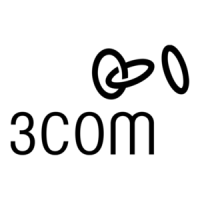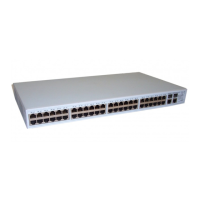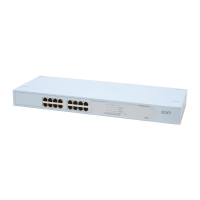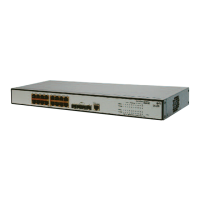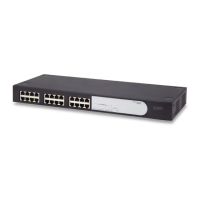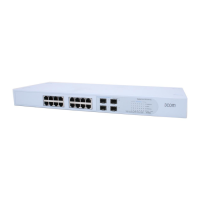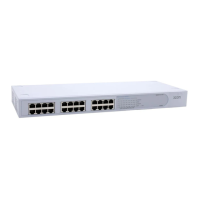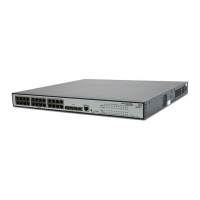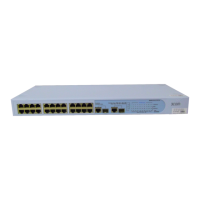Do you have a question about the 3Com 3C16476BS-US - Baseline 2250 Plus Switch and is the answer not in the manual?
Lists text and icon conventions used in the guide.
Lists other documentation related to the switch.
Provides information on how to submit feedback on the documentation.
Provides a general overview of the switch's features and capabilities.
Details the hardware and performance features of the switch.
Explains how ports automatically detect cable type for network connections.
Describes the automatic speed and duplex negotiation for 10/100 Mbps ports.
Details the functionality and use of Small Form Factor Pluggable (SFP) transceiver slots.
Explains the QoS feature that prioritizes network traffic based on defined levels.
Discusses the configuration of forwarding or blocking Bridge Protocol Data Units (BPDU).
Describes the physical components and layout of the switch.
Details the components and LEDs located on the front of the switch.
Describes the connectors and controls found on the rear of the switch.
Lists all the items included in the switch package.
Provides guidelines for selecting an optimal location for the switch.
Explains how to mount the switch in a rack or place it as a standalone unit.
Details the procedure for using the supplied mounting brackets and screws.
Covers the steps for connecting and powering on the switch.
Guides users on how to connect network devices to the switch ports.
Explains the process of installing and removing SFP transceivers.
Lists the compatible SFP transceiver models for the switch.
Provides step-by-step instructions for inserting an SFP transceiver.
Details how to safely remove an SFP transceiver from its slot.
Recommends regular visual inspections for potential issues.
Lists the necessary software and hardware to access the switch's web interface.
Guides users through launching and using the 3Com Discovery application.
Explains how to log in to the switch's web interface using default credentials.
Introduces the layout and navigation of the switch's web management interface.
Describes the main menu structure for accessing switch configurations.
Explains the function of common buttons like Apply, Cancel, and Help.
Details how to view and interpret the status of network ports on the interface.
Describes methods to connect to the web interface without the Discovery tool.
Explains how to find and use an IP address assigned by a DHCP server.
Details how to use a statically configured IP address to access the interface.
Shows how to view basic system settings and component versions.
Provides steps to set or change the administrator password for security.
Explains how to configure the switch's IP address and subnet mask.
Describes the default IP address assignment process based on MAC address.
Details how to manually set the IP address, subnet mask, and gateway.
Covers configuration of port speed, duplex, and flow control.
Allows enabling/disabling ports and setting speed/duplex modes.
Configures broadcast storm control and packet rate thresholds.
Explains how to create and manage Virtual Local Area Networks (VLANs).
Step-by-step guide to creating new VLANs and assigning IDs.
Describes the process for removing existing VLAN groups.
How to change a port's VLAN assignment or mode.
Assigns specific ports to VLAN groups.
Provides examples of common VLAN setups.
Explains how to aggregate multiple ports for increased bandwidth.
Outlines rules and limits for creating trunk groups.
Describes the management of trunk configurations.
Assigns ports to specific trunk groups.
Shows how to check the status and configuration of created trunks.
Details how to use port mirroring for traffic analysis.
Covers system management functions like restart and upgrade.
Explains how to restart the switch to resolve issues.
Covers factory resets, configuration backups, and restores.
Guides on how to update the switch's firmware.
Instructions to restore the switch to its original factory settings.
Steps to recover access if the admin password is lost.
How to regain access if a static IP address is forgotten.
Provides troubleshooting steps for issues indicated by switch LEDs.
Advice on what to do if troubleshooting steps do not resolve an issue.
Explains the importance and process of product registration for warranty benefits.
Information on extended warranty and support services.
Directs users to online resources for troubleshooting.
Explains how to download software updates and maintenance releases.
Provides information on obtaining support via phone and required details.
Lists contact methods and regional support information.
General safety precautions to be followed during installation and operation.
Specific power supply requirements for France and Peru.
Details requirements for the power cord set approved for different countries.
Lists the functional, safety, and EMC standards the switch complies with.
Provides physical dimensions, weight, and mounting details of the switch.
Details electrical specifications including power input and consumption.
Lists text and icon conventions used in the guide.
Lists other documentation related to the switch.
Provides information on how to submit feedback on the documentation.
Provides a general overview of the switch's features and capabilities.
Details the hardware and performance features of the switch.
Explains how ports automatically detect cable type for network connections.
Describes the automatic speed and duplex negotiation for 10/100 Mbps ports.
Details the functionality and use of Small Form Factor Pluggable (SFP) transceiver slots.
Explains the QoS feature that prioritizes network traffic based on defined levels.
Discusses the configuration of forwarding or blocking Bridge Protocol Data Units (BPDU).
Describes the physical components and layout of the switch.
Details the components and LEDs located on the front of the switch.
Describes the connectors and controls found on the rear of the switch.
Lists all the items included in the switch package.
Provides guidelines for selecting an optimal location for the switch.
Explains how to mount the switch in a rack or place it as a standalone unit.
Details the procedure for using the supplied mounting brackets and screws.
Covers the steps for connecting and powering on the switch.
Guides users on how to connect network devices to the switch ports.
Explains the process of installing and removing SFP transceivers.
Lists the compatible SFP transceiver models for the switch.
Provides step-by-step instructions for inserting an SFP transceiver.
Details how to safely remove an SFP transceiver from its slot.
Recommends regular visual inspections for potential issues.
Lists the necessary software and hardware to access the switch's web interface.
Guides users through launching and using the 3Com Discovery application.
Explains how to log in to the switch's web interface using default credentials.
Introduces the layout and navigation of the switch's web management interface.
Describes the main menu structure for accessing switch configurations.
Explains the function of common buttons like Apply, Cancel, and Help.
Details how to view and interpret the status of network ports on the interface.
Describes methods to connect to the web interface without the Discovery tool.
Explains how to find and use an IP address assigned by a DHCP server.
Details how to use a statically configured IP address to access the interface.
Shows how to view basic system settings and component versions.
Provides steps to set or change the administrator password for security.
Explains how to configure the switch's IP address and subnet mask.
Describes the default IP address assignment process based on MAC address.
Details how to manually set the IP address, subnet mask, and gateway.
Covers configuration of port speed, duplex, and flow control.
Allows enabling/disabling ports and setting speed/duplex modes.
Configures broadcast storm control and packet rate thresholds.
Explains how to create and manage Virtual Local Area Networks (VLANs).
Step-by-step guide to creating new VLANs and assigning IDs.
Describes the process for removing existing VLAN groups.
How to change a port's VLAN assignment or mode.
Assigns specific ports to VLAN groups.
Provides examples of common VLAN setups.
Explains how to aggregate multiple ports for increased bandwidth.
Outlines rules and limits for creating trunk groups.
Describes the management of trunk configurations.
Assigns ports to specific trunk groups.
Shows how to check the status and configuration of created trunks.
Details how to use port mirroring for traffic analysis.
Covers system management functions like restart and upgrade.
Explains how to restart the switch to resolve issues.
Covers factory resets, configuration backups, and restores.
Guides on how to update the switch's firmware.
Instructions to restore the switch to its original factory settings.
Steps to recover access if the admin password is lost.
How to regain access if a static IP address is forgotten.
Provides troubleshooting steps for issues indicated by switch LEDs.
Advice on what to do if troubleshooting steps do not resolve an issue.
Explains the importance and process of product registration for warranty benefits.
Information on extended warranty and support services.
Directs users to online resources for troubleshooting.
Explains how to download software updates and maintenance releases.
Provides information on obtaining support via phone and required details.
Lists contact methods and regional support information.
General safety precautions to be followed during installation and operation.
Specific power supply requirements for France and Peru.
Details requirements for the power cord set approved for different countries.
Lists the functional, safety, and EMC standards the switch complies with.
Provides physical dimensions, weight, and mounting details of the switch.
Details electrical specifications including power input and consumption.
| Brand | 3Com |
|---|---|
| Model | 3C16476BS-US |
| Product Line | Baseline |
| Series | 2250 Plus |
| Category | Switch |
| Power Over Ethernet (PoE) | No |
| Form Factor | Rack-mountable |
| Power Supply | Internal |
| Type | Managed |
| Management Type | Managed |
| Layer | Layer 2 |
| MAC Address Table Size | 8K entries |
| Dimensions (W x D x H) | 44 cm x 25.7 cm x 4.4 cm |
| Features | Port mirroring |
| Compliant Standards | IEEE 802.3, IEEE 802.3u, IEEE 802.3ab, IEEE 802.3x |
